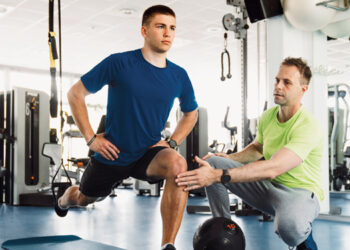How SportsArt is using innovation to sustain the health of the planet and its people.
According to the 2021 Global Sustainability Study, “85% of people indicate they have shifted their purchase behavior toward being more sustainable in the past five years.”
In addition, according to research from Accenture, “Nearly two-thirds of consumers globally (63%) prefer to buy goods and services from companies that stand for a shared purpose that reflects their personal values and beliefs.”
One company on the forefront of this movement is SportsArt. Founded in 1977 by Paul Kuo, the green equipment manufacturer’s mission is to bring to market beautiful, intelligent, innovative products and technologies that play a role in sustaining the health of the planet and its people.
“With offices around the world servicing 80 countries, we believe we must use our vast reach to encourage sustainable and renewable practices from manufacturing to the equipment in use,” said Carina Kuo, the chief operating officer of SportsArt. “We strive to create a network of like-minded partners focused on inspiring positive social impact and stewarding the beautiful world we have been given.”
How is this mission carried out in practice?
First, SportsArt is committed to leading the fitness industry in eco-friendly action through research, design and education on sustainable solutions and practices.
“We have dedicated a lot of time and resources to ensure our forward-thinking innovation allows us to create products that are socially and environmentally responsible, and solve problems for club owners,” said Carina. “Our innovative technology is what sets SportsArt apart.”
Take SportsArt’s ECO-POWR line as an example, which can convert up to 74% of human energy into usable electricity. This gives member workouts an additional purpose — offsetting a gym’s carbon footprint and providing cost savings for the gym owner.
“For example, traditional treadmills on average use about one kilowatt an hour,” explained Ruben Mejia, the executive vice president of SportsArt, Americas. “That is equivalent to a refrigerator running for five hours. With SportsArt’s non-motorized ECO-POWR treadmills, a facility will not be buying one kilowatt from the electricity company. And they’ll have the ability to generate up to an additional 200 watt-hours. In layman’s terms, a facility can be net positive 1.2 kilowatts of electricity per hour with just a single treadmill.”

Earlier this year, SportsArt also unveiled its G260 ECO-POWR rower at the Consumer Electronics Show, which also has energy-generating capabilities.
“The launch of this equipment is inspiring because it’s just one more way to help offset a gym’s carbon footprint,” explained Carina. “What’s also great about this newest piece of equipment is that it’s very functional. The rower can fit so many needs, from people looking for a low-impact workout to those looking for a HIIT workout, all while doing good for the environment.”
Beyond its eco-friendly products, SportsArt is also committed to education, working with partners to understand the upside of eco-friendly equipment and solutions. This upside doesn’t just include cost-savings, but also brand building and member retention.
“It’s undeniable sustainability is becoming a central ethos embraced across all sectors in today’s world, including the fitness industry,” said Carina. “Sustainable fitness solutions, like SportsArt’s ECO-POWR line of cardio equipment, can help set facilities apart and be a driver for increased engagement with current and new members.”
SportsArt doesn’t expect prospective customers to just take its word as truth, however. The team has been known to put professionals in touch with one another so they can get unfiltered opinions on if the equipment is worth it.
“We can scream from the top of our lungs about how great we are, but it’s much more compelling when someone else says it,” said Carina.
In fact, going above and beyond for customers is another way SportsArt stands apart, working hand-in-hand with clients to ensure a successful relationship for the long-run.
“The success of SportsArt hasn’t come just because we produce quality equipment — it’s been the fact we go above and beyond for clients,” said Mejia. “Since the beginning in 1977, we never wanted to be an organization that simply gave you a quote and disappeared when you signed the dotted line.”
With that in mind, Carina and Mejia shared the advice they give to operators today as the industry seeks to rebound from a challenging two years:
“First and foremost, I would say it’s vital for clubs to show their value,” said Carina. “When selecting cardio equipment for your fitness facility, focusing only on features and benefits can be easy. SportsArt has you covered with equipment that delivers an incredible user experience, as well as the durability and reliability you demand. However, it would help if you also considered how your equipment extends your brand values.”
Second, Mejia advised clubs to explore new ways to engage with members. “As fitness enthusiasts find their way back to their favorite workout facility, you need new ways to keep them engaged and excited,” he said.
Last but not least, Carina recommended gyms focus on inclusivity to ensure there is something for everyone. “The purpose of the fitness industry is to encourage people to achieve greater health and well-being,” she said. “Not just people who are already healthy, but all people — the young, old, healthy, chronically ill, and those with and without disabilities.”
This advice speaks to SportsArt’s original goal of making a positive impact on both the planet and the people who reside on it.

“We believe serving others is more rewarding than serving ourselves,” said Mejia. “We want people to remember the SportsArt name for designing and manufacturing exercise and rehabilitation machines that allow everyone the ability to exercise.”
But to ensure this goal is achieved, it’s important for SportsArt to do its part in protecting the planet. That is why beyond just creating eco-friendly products, the company is practicing what it preaches.
“Our latest manufacturing facility incorporates a number of energy-saving and resource-conservation elements,” explained Mejia. “Large rainwater collection tanks provide water used in the manufacturing process. Solar panels provide a half of the electricity the facility uses in a year. And special solar-reflective glass reduces the amount of energy required to cool the building. We’ve also made a few simple changes that make a big difference, like using sustainable cleaning products, drastically reducing the number of printed materials we create, and using reusable or compostable utensils in our offices.”
“Providing a way to preserve the planet through our operations as a global brand is of the utmost importance to SportsArt,” echoed Carina. “Our goal remains to be focused on changing the world one workout at
a time.”
Stay ahead in the fitness industry with exclusive updates!
Rachel Zabonick-Chonko is the editor-in-chief of Club Solutions Magazine. She can be reached at rachel@peakemedia.com.











